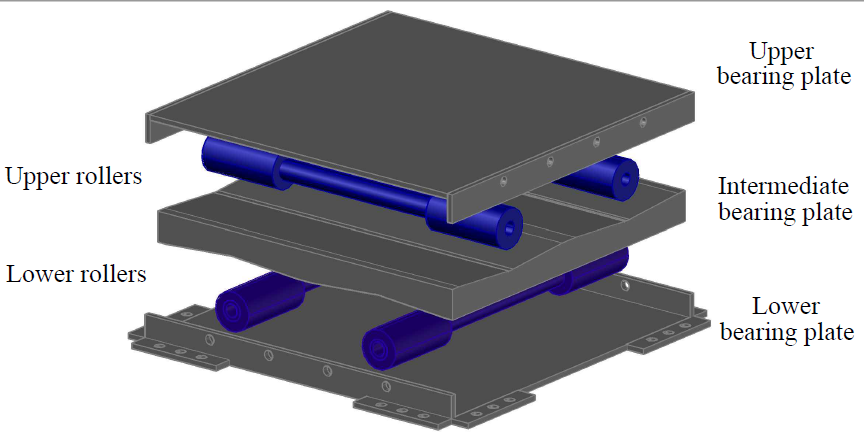
Published
Numerical Assessment of Bidirectional Roller Bearing Isolators under Near-Fault Earthquakes
Evaluación numérica de aisladores de soportes rodantes bidireccionales sometidos a sismos cercanos a la falla
DOI:
https://doi.org/10.15446/ing.investig.104078Keywords:
base isolation, nonlinear seismic response, supplementary dissipation mechanism, inclination angle (en)aislamiento de base, respuesta sísmica no lineal, mecanismo de disipación suplementario, ángulo de inclinación (es)
Downloads
In this research, a bidirectional seismic isolation device composed of sloped bearing plates and multiple rollers arranged in both orthogonal-in-plane directions is numerically studied. A previous analytical model of a single direction of roller bearing (RB) system is extended to a two-direction RB system. Several experimental tests in a physical building model with and without an RB system are used to validate the numerical model. The model is used to perform the nonlinear response of a four-story multi-column building when subjected to pairs of scaled near-fault earthquake records. The effect of the inclination angle of bearing plates in the range of 1.0° to 4.0°, the sliding friction force, and supplementary damping mechanisms ranging from 0.0 to 0.5 N/kg (i.e. friction force normalized with the structure mass) are also investigated. The results show that the proposed bidirectional RB system is suitable for reducing the seismic response of stiff and flexible multi-column structures. In particular, the RB system reduces the acceleration responses by 5% to 85% in flexible structures and 86% to 96% in stiff structures. Furthermore, bearing plates with an inclination angle greater than or equal to 3.0° have significant benefits in terms of self-centering capacity.
En este trabajo de investigación se estudia la efectividad de un sistema de aislamiento sísmico bidireccional compuesto por superficies de rodamiento inclinadas y múltiples rodillos dispuestos en ambas direcciones ortogonales en el plano. Resultados experimentales anteriores de aisladores sísmicos de soportes rodantes unidireccionales y bidireccionales (RB), fueron utilizados para validar un modelo numérico 3D de edificios con RB. Este modelo de comportamiento no lineal se utilizó para obtener la respuesta de un edificio de cuatro pisos sometido a pares de registros escalados de terremotos cercanos a la falla. Este estudio, investiga el efecto del ángulo de inclinación de las superficies rodantes en el rango de 1.0° a 4.0°, la fuerza de fricción por rodamiento y los mecanismos de disipación de energía por deslizamiento, tomando una variación entre 0.0 a 0.5 N/kg en la magnitud de la fuerza de fricción normalizada respecto a la masa de la estructura. Los resultados muestran que el sistema RB propuesto es adecuado para reducir la respuesta sísmica de edificios con comportamiento rígido y flexible. En particular, el sistema RB reduce las respuestas de aceleración entre un 5 % y un 85 % en estructuras flexibles y entre un 86 % y un 96 % en estructuras rígidas. Además, las superficies con un ángulo de inclinación mayor o igual a 3,0° muestran ventajas significativas en relación a la capacidad de auto centrado.
References
Ancheta, T., Darragh, R., Stewart, J., Seyhan, E., Silva, W., Chiou, B., Wooddell, K., Graves, R., Kottke, A., Boore, D., Kishida, T., and Donahue, J. (2013). PEER NGA-West2 Database (Technical Report PEER 2013/03). Pacific Earthquake Engineering Research Center (PEER). https://doi.org/10.1193/070913EQS197M
Andreaus, U., and De Angelis, M. (2020). Influence of the characteristics of isolation and mitigation devices on the response of single-degree-of-freedom vibro-impact systems with two-sided bumpers and gaps via shaking table tests. Structural Control and Health Monitoring, 27(5), e2517. https://doi.org/10.1002/stc.2517
Bagerzadeh-Karimi, M., and Geneç, M. (2019). Probabilistic behavior assessment of base-isolated buildings and base isolation systems subjected to various earthquakes with different components. Arabian Journal for Science and Engineering, 44(10), 8265-8288. https://doi.org/10.1007/s13369-019-03867-x
Beirami-Shahabi, A., Zamani-Ahari, G., and Barghian, M. (2019). Suspended columns for seismic isolation in structures (SCSI): A preliminary analytical study. Earthquakes and Structures, 16(6), 743-755.
Beirami-Shahabi, A., Zamani-Ahari, G., and Barghian, M. (2020). Base isolation systems: A state of the art review according to their mechanism. Journal of Rehabilitation in Civil Engineering, 8(2), 37-61.
Calhoun, S. (2018). Evaluation of rolling-type isolation systems for seismic hazard mitigation [Master's thesis, The University of Oklahoma].
Calhoun, S., Tehrani, M., and Harvey-Jr, P. (2019). On the performance of double rolling isolation systems. Journal of Sound and Vibration, 449, 330-348. https://doi.org/10.1016/j.jsv.2019.02.030
Chen, P., Hsu, S., Zhong, Y., and Wang, S. (2021). Real-time hybrid simulation of smart base-isolated raised floor systems for high-tech industry. Smart Structures and Systems, 23(1), 91-106.
Chen, X., Liu, Y., Zhou, B., and Yang, D. (2020). Seismic response analysis of intake tower structure under near-fault ground motions with forward-directivity and fling-step effects. Soil Dynamics and Earthquake Engineering, 132, 106098. https://doi.org/10.1016/j.soildyn.2020.106098
De Luca, A., and Guidi, L. (2019). State of art in the worldwide evolution of base isolation design. Soil Dynamics and Earthquake Engineering, 125, 105722. https://doi.org/10.1016/j.soildyn.2019.105722
Donahue, J., and Abrahamson, N. (2014). Simulation-based hanging wall effects. Earthquake Spectra, 30(3), 1269-1284. https://doi.org/10.1193/071113EQS200M
Erdik, M., Ülker, O., Şadan, B., and Tüzün, C. (2018). Seismic isolation code developments and significant applications in Turkey. Soil Dynamics and Earthquake Engineering, 115, 413-437. https://doi.org/10.1016/j.soildyn.2018.09.009
Foti, D. (2019). Rolling devices for seismic isolation of lightweight structures and equipment. Design and realization of a prototype. Structural Control and Health Monitoring, 26(3), e2311. https://doi.org/10.1002/stc.2311
Foti, D., Catalan Goni, A., and Vacca, S. (2013). On the dynamic response of rolling base isolation systems. Structural Control and Health Monitoring, 20(4), 639-648. https://doi.org/10.1002/stc.1538
Harvey-Jr, P., and Gavin, H. (2015). Assessment of a rolling isolation system using reduced order structural models. Engineering Structures, 99, 708-725. https://doi.org/10.1016/j.engstruct.2015.05.022
Hosseini, M., and Soroor, A. (2011). Using orthogonal pairs of rollers on concave beds (OPRCB) as a base isolation system. Part I: Analytical, experimental and numerical studies of (OPRCB) isolators. The Structural Design of Tall and
Special Buildings, 20, 928-950. https://doi.org/10.1002/tal.568
Hosseini, M., and Soroor, A. (2013). Using orthogonal pairs of rollers on concave beds (OPRCB) as a base isolation system. Part II: Application to multi-story and tall buildings. The Structural Design of Tall and Special Buildings, 22, 192-216. https://doi.org/10.1002/tal.671
Jangid, R. (2000). Stochastic seismic response of structures isolated by rolling rods. Journal of Structural Engineering, 22(8), 937-946. https://doi.org/10.1016/S0141-0296(99)00041-3
Kausel, E., and Ushijima, R. (1979). Baseline correction of earthquake records in the frequency domain (Technical Report R79-34). Massachusetts Institute of Technology.
Lee, G., Liang, Z., and Snyder, G. (2005). Seismic isolation bearing. PCT WO 2005/031088 A2. https://www.researchgate.net/figure/Scheme-of-loading-frame-designed-for-testing-of-two-seismic-isolation-
bearings-of_fig1_324517378
Lee, G., Ou, Y., Niu, T., Song, J., and Liang, Z. (2010). Characterization of a roller seismic isolation bearing with supplemental energy dissipation for highway bridges. Journal of Structural Engineering, 136(5), 502-510. https://doi.org/10.1061/(ASCE)ST.1943-541X.0000136
Matsagar, V., and Jangid, R. (2008). Base isolation for seismic retrofitting of structures. Practice Periodical on Structural Design and Construction, 13(14), 175-185. https://doi.org/10.1061/(ASCE)1084-0680(2008)13:4(175)
Menga, N., Foti, D., and Carbone, G. (2017). Viscoelastic frictional properties of rubber-layer roller bearings (RLRB) seismic isolators. Meccanica, 52, 2807-2817. https://doi.org/10.1007/s11012-016-0612-y
Mukhopadhyay, S., and Gupta, V. (2013). Directivity pulses in near-fault ground motions—I: Identification, extraction and modeling. Soil Dynamics and Earthquake Engineering, 50, 1-15. https://doi.org/10.1016/j.soildyn.2013.02.017
Naeim, F., and Kelly, J. (1999). Design of seismic isolated structures: From theory to practice. Wiley and Sons. https://doi.org/10.1002/9780470172742
Nobari Azar, F., Karimzadeh Naghshineh, A., and Sen, M. (2022). Preparation and characterization of natural rubber-based new elastomers for high-damping base isolation systems. Journal of Elastomers and Plastics, 54(6), 959-974. https://doi.org/10.1177/00952443221075505
Ortiz-Cano, N. (2013). Avaliação de sistemas de isolamento para o controle de vibrações de edifícios submetidos a excitações de base [PhD thesis, Universidade Federal do Rio de Janeiro].
Ortiz-Cano, N., Magluta, C., and Roitman, N. (2014). Numerical and experimental studies of a building with elastomeric and roller seismic isolation bearing [Conference Presentation]. 9th International Conference on Structural Dynamics, Porto, Portugal.
Ortiz-Cano, N., Magluta, C., and Roitman, N. (2015). Numerical and experimental studies of a building with roller seismic isolation bearings. Structural Engineering and Mechanics, 54(3), 475-489. https://doi.org/10.12989/sem.2015.54.3.475
Ou, Y., Song, J., and Lee, G. (2010). A parametric study of seismic behavior of roller seismic isolation bearings for highway bridges. Earthquake Engineering and Structural Dynamics, 39(5), 541-559. https://doi.org/10.1002/eqe.958
Quanser Consulting Inc. (2010). Make Quake Program [Computer software]. Quanser Consulting Inc.
Rawat, A., and Matsagar, V. (2021). An oblate spheroid base isolator and floating surface diaphragm for seismic protection of liquid storage tank. Journal of Earthquake Engineering, 26(10), 5447-5475. https://doi.org/10.1080/13632469.2021.1875939
Rawat, A., Ummer, N., and Matsagar, V. (2018). Performance of bi-directional elliptical rolling rods for base isolation of buildings under near-fault earthquakes. Advances in Structural Engineering, 21(5), 675-693. https://doi.org/10.1177/1369433217726896
Ryan, K., Okazaki, T., Coria, C., Sato, E., and Sasaki, T. (2018). Response of hybrid isolation system during a shake table experiment of a full-scale isolated building. Earthquake Engineering and Structural Dynamics, 47, 2214-2232. https://doi.org/10.1002/eqe.3065
Sanchez-Torres, D., Rico-Caviedes, A., Ortiz-Cano, N., Nieto-Leal, A., and Gaviria-Mendoza, C. (2019). Assessment of a roller seismic isolation bearing for buildings under bidirectional excitations [Conference presentation]. XL Ibero-Latin-American Congress on Computational Methods in Engineering, Rio Grande do Norte, Brazil.
Shampine, L., Reichelt, M., and Kierzenka, J. (1999). Solving Index-1 DAEs in MATLAB and Simulink. SIAM Review, 18(3), 538-552. https://doi.org/10.1137/S003614459933425X
The MathWorks Inc. (2019). MATLAB R2019a [Computer software]. The Mathworks Inc.
Tsai, H., Lin, B., and Huang, C. (2007). Shaking table tests of a scaled bridge model with rolling-type seismic isolation bearings. Engineering Structures, 29, 694-702. https://doi.org/10.1016/j.engstruct.2006.05.025
Walters, M. (2015, July). Seismic isolation: The gold standard of seismic protection. Structure Magazine. https://www.structuremag.org/?p=8770#:~:text=The%20currently%20applicable%20concept%20of,as%20the%20earth%20moves%20violently.
Wang, S., Hwang, J., Chang, K., Shiau, C., Lin, W., Tsai, M., Hong, J., and Yang, Y. (2014). Sloped multi-roller isolation devices for seismic protection of equipment and facilities. Earthquake Engineering and Structural Dynamics, 43, 1443–1461. https://doi.org/10.1002/eqe.2404
Wang, S., Lin, W., Yang, C., Chang, K., Huang, Y., Hwang, J., and Hwang, J. (2017). Recent progress in Taiwan on seismic isolation, energy dissipation, and active vibration control [Conference presentation]. Presented at the 15th World Conference on Seismic Isolation, Energy Dissipation, and Active Vibration Control of Structures, Wellington, New Zealand.
Zhang, C., and Ali, A. (2021). The advancement of seismic isolation and energy dissipation mechanisms based on friction. Soil Dynamics and Earthquake Engineering, 146, 106746. https://doi.org/10.1016/j.soildyn.2021.106746
How to Cite
APA
ACM
ACS
ABNT
Chicago
Harvard
IEEE
MLA
Turabian
Vancouver
Download Citation
CrossRef Cited-by
1. Brayan N. Panesso, María F. Gualteros, Nicolas F. Vanegas, Nelson A. Ortiz. (2025). Experimental Vibration Analysis for Civil Engineering Structures. Lecture Notes in Civil Engineering. 676, p.681. https://doi.org/10.1007/978-3-031-96114-4_70.
Dimensions
PlumX
Article abstract page views
Downloads
License
Copyright (c) 2024 Ricardo González-Olaya, Nelson Andrés Ortiz-Cano, Carlos Andrés Gaviria-Mendoza, Carlos Magluta, Ney Roitman

This work is licensed under a Creative Commons Attribution 4.0 International License.
The authors or holders of the copyright for each article hereby confer exclusive, limited and free authorization on the Universidad Nacional de Colombia's journal Ingeniería e Investigación concerning the aforementioned article which, once it has been evaluated and approved, will be submitted for publication, in line with the following items:
1. The version which has been corrected according to the evaluators' suggestions will be remitted and it will be made clear whether the aforementioned article is an unedited document regarding which the rights to be authorized are held and total responsibility will be assumed by the authors for the content of the work being submitted to Ingeniería e Investigación, the Universidad Nacional de Colombia and third-parties;
2. The authorization conferred on the journal will come into force from the date on which it is included in the respective volume and issue of Ingeniería e Investigación in the Open Journal Systems and on the journal's main page (https://revistas.unal.edu.co/index.php/ingeinv), as well as in different databases and indices in which the publication is indexed;
3. The authors authorize the Universidad Nacional de Colombia's journal Ingeniería e Investigación to publish the document in whatever required format (printed, digital, electronic or whatsoever known or yet to be discovered form) and authorize Ingeniería e Investigación to include the work in any indices and/or search engines deemed necessary for promoting its diffusion;
4. The authors accept that such authorization is given free of charge and they, therefore, waive any right to receive remuneration from the publication, distribution, public communication and any use whatsoever referred to in the terms of this authorization.


























